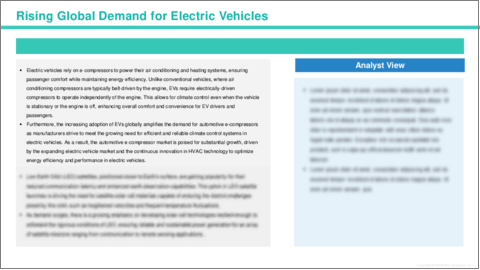|
|
市場調査レポート
商品コード
1496684
自動車用Eコンプレッサー市場- 世界と地域別分析:車両タイプ別、コンプレッサータイプ別、容量別、推進タイプ別、技術タイプ別、地域別 - 分析と予測(2024年~2034年)Automotive E-Compressor Market - A Global and Regional Analysis: Focus on Vehicle Type, Compressor Type, Capacity, Propulsion Type, Technology Type, and Region - Analysis and Forecast, 2024-2034 |
||||||
カスタマイズ可能
|
|||||||
| 自動車用Eコンプレッサー市場- 世界と地域別分析:車両タイプ別、コンプレッサータイプ別、容量別、推進タイプ別、技術タイプ別、地域別 - 分析と予測(2024年~2034年) |
|
出版日: 2024年06月19日
発行: BIS Research
ページ情報: 英文 100 Pages
納期: 1~5営業日
|
- 全表示
- 概要
- 目次
自動車産業は、技術の急速な進化と環境への関心の高まりにより、大きな変革期を迎えています。
この変化を先導する極めて重要なコンポーネントの一つが自動車用Eコンプレッサーであり、自動車、特に電気自動車やハイブリッド車の熱管理システムに不可欠な装置です。よりクリーンで効率的な自動車を求める動きが強まるにつれ、自動車用e-コンプレッサー市場は大幅な成長を遂げ、業界の利害関係者にとって重要な注目分野となっています。楽観的な予測では、2024年に69億米ドルだった市場規模は、今後11.63%のCAGRで拡大し、2034年には207億2,000万米ドルに達すると予測されています。
| 主要市場統計 | |
|---|---|
| 予測期間 | 2024年~2034年 |
| 2024年の評価 | 69億米ドル |
| 2034年の予測 | 207億2,000万米ドル |
| CAGR | 11.63% |
自動車用Eコンプレッサーは、従来のベルト駆動コンプレッサーとは異なり、自動車のバッテリーから直接電力を供給されます。この設計は、機械的な連結に伴う一般的なエネルギー損失を排除して効率を向上させるだけでなく、コンプレッサーの配置をより柔軟にすることができ、電気自動車(EV)のコンパクトなエンジンベイでは特に有益です。世界のEV導入の増加は、急成長するEコンプレッサー市場の主な促進要因です。主要経済国が二酸化炭素排出量の削減に取り組んでおり、内燃エンジン車の段階的廃止を計画している国もあるため、高度で効率的な熱管理ソリューションの需要が急増しています。
自動車用Eコンプレッサー市場は、より持続可能で効率的な輸送ソリューションに向けた自動車業界の進化の最前線にあります。電気自動車技術の絶え間ない進歩と、低排出ガスに対する規制要求の高まりにより、自動車の設計と機能性におけるEコンプレッサーの役割はますます重要になっており、この市場の堅調な成長見通しを示しています。技術が進歩し、採用率が急上昇するにつれて、自動車用Eコンプレッサー市場は、自動車技術と持続可能性への取り組みにおける広範な動向を反映して、拡大すると予想されます。
当レポートでは、世界の自動車用Eコンプレッサー市場について調査し、市場の概要とともに、車両タイプ別、コンプレッサータイプ別、容量別、推進タイプ別、技術タイプ別、地域別の動向、および市場に参入する企業のプロファイルなどを提供しています。
目次
エグゼクティブサマリー
第1章 市場:業界の展望
- 動向:現在および将来の影響評価
- サプライチェーンの概要
- R&Dレビュー
- 規制状況
- ステークホルダー分析
- 主要な世界的イベントの影響分析
- 市場力学の概要
第2章 自動車用Eコンプレッサー市場(用途別)
- 用途のセグメンテーション
- 用途の概要
- 自動車用Eコンプレッサー市場(車両タイプ別)
第3章 自動車用Eコンプレッサー市場(製品別)
- 製品セグメンテーション
- 製品概要
- 自動車用Eコンプレッサー市場(コンプレッサータイプ別)
- 自動車用Eコンプレッサー市場(容量別)
- 自動車用Eコンプレッサー市場(推進タイプ別)
- 自動車用Eコンプレッサー市場(技術タイプ別)
第4章 自動車用Eコンプレッサー市場(地域別)
- 自動車用Eコンプレッサー市場(地域別)
- 北米
- 欧州
- アジア太平洋
- その他の地域
第5章 企業プロファイル
- 今後の見通し
- 地理的評価
- Denso Corporation
- Hanon Systems
- Mahle GmbH
- Mitsubishi Heavy Industries, Ltd.
- Robert Bosch GmbH
- Sanden Corporation
- Brose Fahrzeugteile SE & CO. KG, Coburg
- Toyota Industries Corporation
- Valeo
- Aotejia New Energy Technology Co., Ltd.
- Highly Marelli Holdings Co., Ltd.
- TCCI Manufacturing
- Guchen Industry
- Stealth EV
- Siroco HVAC India Pvt. Ltd.
- その他
第6章 調査手法
Introduction to Automotive E-Compressor Market
The automotive industry is experiencing a significant transformation driven by the rapid evolution of technology and growing environmental concerns. One of the pivotal components spearheading this shift is the automotive e-compressor, an essential device in the thermal management systems of vehicles, particularly electric and hybrid models. As the push for cleaner, more efficient vehicles intensifies, the automotive e-compressor market is poised for substantial growth, making it a critical area of focus for industry stakeholders. In an optimistic forecast, the market, valued at $6.90 billion in 2024, is anticipated to grow at a CAGR of 11.63%, reaching $20.72 billion by 2034.
| KEY MARKET STATISTICS | |
|---|---|
| Forecast Period | 2024 - 2034 |
| 2024 Evaluation | $6.90 Billion |
| 2034 Forecast | $20.72 Billion |
| CAGR | 11.63% |
An automotive e-compressor, distinct from traditional belt-driven compressors, is powered directly by a vehicle's battery. This design not only improves efficiency by eliminating the energy losses typically associated with mechanical linkages but also allows for greater flexibility in compressor placement, which is particularly beneficial in the compact engine bays of electric vehicles (EVs). The rise in EV adoption globally is a primary driver of the burgeoning e-compressor market. With major economies committing to reduce carbon emissions and some planning to phase out internal combustion engine vehicles, the demand for advanced, efficient thermal management solutions is surging. For instance, Tesla's continuous innovation in thermal management systems for its EV lineup highlights the role of advanced e-compressors in enhancing vehicle performance and battery efficiency. Similarly, Toyota's collaboration with Denso to develop next-generation climate control systems for their hybrid and electric models demonstrates the industry's focus on optimizing e-compressor technology to improve overall vehicle efficiency and comfort.
In conclusion, the automotive e-compressor market is at the forefront of the automotive industry's evolution towards more sustainable and efficient transportation solutions. With the continuous advancements in electric vehicle technology and increasing regulatory demands for lower emissions, the e-compressor's role in vehicle design and functionality is becoming increasingly critical, signalling robust growth prospects for this market. As technology progresses and adoption rates soar, the automotive e-compressor market is expected to expand, reflecting the broader trends in automotive technology and sustainability efforts.
Market Segmentation:
Segmentation 1: by Vehicle Type
- Passenger Cars
- Light Commercial Vehicles
- Heavy Commercial Vehicles
Segmentation 2: by Compressor Type
- Scroll Compressors
- Rotary Compressors
- Centrifugal Compressors
- Reciprocating Compressors
- Axial Compressors
Segmentation 3: by Capacity
- Small
- Medium
- Large
Segmentation 4: by Propulsion Type
- Battery Electric Vehicle (BEV)
- Plug-in Hybrid Vehicle (PHEV)
- Fuel-cell Electric Vehicle (FCEV)
- Hybrid Electric Vehicle (HEV)
Segmentation 5: by Technology Type
- VFD
- Fixed Speed
Segmentation 6: by Region
- North America
- Europe
- Asia-Pacific
- Rest-of-the-World
How can this report add value to an organization?
Product/Innovation Strategy: The global automotive e-compressor market has been extensively segmented based on various categories, such as vehicle type, compressor type, capacity type, propulsion type, and technology type. This can help readers get a clear overview of which segments account for the largest share and which ones are well-positioned to grow in the coming years.
Competitive Strategy: A detailed competitive benchmarking of the players operating in the global automotive e-compressor market has been done to help the reader understand how players stack against each other, presenting a clear market landscape. Additionally, comprehensive competitive strategies such as partnerships, agreements, and collaborations will aid the reader in understanding the untapped revenue pockets in the market.
Key Market Players and Competition Synopsis
The companies that are profiled have been selected based on thorough secondary research, which includes analyzing company coverage, product portfolio, market penetration, and insights gathered from primary experts.
Some of the prominent companies in this market are:
- Denso Corporation
- Hanon Systems
- Mahle GmbH
- Mitsubishi Heavy Industries, Ltd.
- Sanden Corporation
- Valeo
Key Questions Answered
- What are the main factors driving the demand for automotive e-compressor market?
- What are the major patents filed by the companies active in the automotive e-compressor market?
- Who are the key players in the automotive e-compressor market, and what are their respective market shares?
- What partnerships or collaborations are prominent among stakeholders in the automotive e-compressor market?
- What are the strategies adopted by the key companies to gain a competitive edge in automotive e-compressor market?
- What is the futuristic outlook for the automotive e-compressor market in terms of growth potential?
- What is the current estimation of the automotive e-compressor market and what growth trajectory is projected from 2024 to 2034?
- Which application, and product segment is expected to lead the market over the forecast period (2024-2034)?
- Which regions demonstrate the highest adoption rates for automotive e-compressor market, and what factors contribute to their leadership?
Table of Contents
Executive Summary
Scope and Definition
Market/Product Definition
Key Questions Answered
Analysis and Forecast Note
1. Markets: Industry Outlook
- 1.1 Trends: Current and Future Impact Assessment
- 1.2 Supply Chain Overview
- 1.2.1 Value Chain Analysis
- 1.2.2 Pricing Forecast
- 1.3 R&D Review
- 1.3.1 Patent Filing Trend by Country, by Company
- 1.4 Regulatory Landscape
- 1.5 Stakeholder Analysis
- 1.5.1 Use Case
- 1.5.2 End User and Buying Criteria
- 1.6 Impact Analysis for Key Global Events
- 1.7 Market Dynamics Overview
- 1.7.1 Market Drivers
- 1.7.2 Market Restraints
- 1.7.3 Market Opportunities
2. Automotive E-Compressor Market (by Application)
- 2.1 Application Segmentation
- 2.2 Application Summary
- 2.3 Automotive E-Compressor Market (by Vehicle Type)
- 2.3.1 Passenger Cars
- 2.3.2 Light Commercial Vehicles
- 2.3.3 Heavy Commercial Vehicles
3. Automotive E-Compressor Market (by Product)
- 3.1 Product Segmentation
- 3.2 Product Summary
- 3.3 Automotive E-Compressor Market (by Compressor Type)
- 3.3.1 Scroll Compressors
- 3.3.2 Rotary Compressors
- 3.3.3 Centrifugal Compressors
- 3.3.4 Reciprocating Compressors
- 3.3.5 Axial Compressors
- 3.4 Automotive E-Compressor Market (by Capacity)
- 3.4.1 Small
- 3.4.2 Medium
- 3.4.3 Large
- 3.5 Automotive E-Compressor Market (by Propulsion Type)
- 3.5.1 Battery Electric Vehicle (BEV)
- 3.5.2 Plug-in Hybrid Vehicle (PHEV)
- 3.5.3 Fuel-cell Electric Vehicle (FCEV)
- 3.5.4 Hybrid Electric Vehicle (HEV)
- 3.6 Automotive E-Compressor Market (by Technology Type)
- 3.6.1 VFD
- 3.6.2 Fixed Speed
4. Automotive E-Compressor Market (by Region)
- 4.1 Automotive E-Compressor Market (by Region)
- 4.2 North America
- 4.2.1 Regional Overview
- 4.2.2 Driving Factors for Market Growth
- 4.2.3 Factors Challenging the Market
- 4.2.4 Application
- 4.2.5 Product
- 4.2.6 U.S.
- 4.2.6.1 Market by Application
- 4.2.6.2 Market by Product
- 4.2.7 Canada
- 4.2.7.1 Market by Application
- 4.2.7.2 Market by Product
- 4.2.8 Mexico
- 4.2.8.1 Market by Application
- 4.2.8.2 Market by Product
- 4.3 Europe
- 4.3.1 Regional Overview
- 4.3.2 Driving Factors for Market Growth
- 4.3.3 Factors Challenging the Market
- 4.3.4 Application
- 4.3.5 Product
- 4.3.6 Germany
- 4.3.6.1 Market by Application
- 4.3.6.2 Market by Product
- 4.3.7 France
- 4.3.7.1 Market by Application
- 4.3.7.2 Market by Product
- 4.3.8 U.K.
- 4.3.8.1 Market by Application
- 4.3.8.2 Market by Product
- 4.3.9 Italy
- 4.3.9.1 Market by Application
- 4.3.9.2 Market by Product
- 4.3.10 Rest-of-Europe
- 4.3.10.1 Market by Application
- 4.3.10.2 Market by Product
- 4.4 Asia-Pacific
- 4.4.1 Regional Overview
- 4.4.2 Driving Factors for Market Growth
- 4.4.3 Factors Challenging the Market
- 4.4.4 Application
- 4.4.5 Product
- 4.4.6 China
- 4.4.6.1 Market by Application
- 4.4.6.2 Market by Product
- 4.4.7 Japan
- 4.4.7.1 Market by Application
- 4.4.7.2 Market by Product
- 4.4.8 India
- 4.4.8.1 Market by Application
- 4.4.8.2 Market by Product
- 4.4.9 South Korea
- 4.4.9.1 Market by Application
- 4.4.9.2 Market by Product
- 4.4.10 Rest-of-Asia-Pacific
- 4.4.10.1 Market by Application
- 4.4.10.2 Market by Product
- 4.5 Rest-of-the-World
- 4.5.1 Regional Overview
- 4.5.2 Driving Factors for Market Growth
- 4.5.3 Factors Challenging the Market
- 4.5.4 Application
- 4.5.5 Product
- 4.5.6 South America
- 4.5.6.1 Market by Application
- 4.5.6.2 Market by Product
- 4.5.7 Middle East and Africa
- 4.5.7.1 Market by Application
- 4.5.7.2 Market by Product
5. Companies Profiled
- 5.1 Next Frontiers
- 5.2 Geographic Assessment
- 5.2.1 Denso Corporation
- 5.2.1.1 Overview
- 5.2.1.2 Top Products/Product Portfolio
- 5.2.1.3 Top Competitors
- 5.2.1.4 Target Customers
- 5.2.1.5 Key Personnel
- 5.2.1.6 Analyst View
- 5.2.1.7 Market Share
- 5.2.2 Hanon Systems
- 5.2.2.1 Overview
- 5.2.2.2 Top Products/Product Portfolio
- 5.2.2.3 Top Competitors
- 5.2.2.4 Target Customers
- 5.2.2.5 Key Personnel
- 5.2.2.6 Analyst View
- 5.2.2.7 Market Share
- 5.2.3 Mahle GmbH
- 5.2.3.1 Overview
- 5.2.3.2 Top Products/Product Portfolio
- 5.2.3.3 Top Competitors
- 5.2.3.4 Target Customers
- 5.2.3.5 Key Personnel
- 5.2.3.6 Analyst View
- 5.2.3.7 Market Share
- 5.2.4 Mitsubishi Heavy Industries, Ltd.
- 5.2.4.1 Overview
- 5.2.4.2 Top Products/Product Portfolio
- 5.2.4.3 Top Competitors
- 5.2.4.4 Target Customers
- 5.2.4.5 Key Personnel
- 5.2.4.6 Analyst View
- 5.2.4.7 Market Share
- 5.2.5 Robert Bosch GmbH
- 5.2.5.1 Overview
- 5.2.5.2 Top Products/Product Portfolio
- 5.2.5.3 Top Competitors
- 5.2.5.4 Target Customers
- 5.2.5.5 Key Personnel
- 5.2.5.6 Analyst View
- 5.2.5.7 Market Share
- 5.2.6 Sanden Corporation
- 5.2.6.1 Overview
- 5.2.6.2 Top Products/Product Portfolio
- 5.2.6.3 Top Competitors
- 5.2.6.4 Target Customers
- 5.2.6.5 Key Personnel
- 5.2.6.6 Analyst View
- 5.2.6.7 Market Share
- 5.2.7 Brose Fahrzeugteile SE & CO. KG, Coburg
- 5.2.7.1 Overview
- 5.2.7.2 Top Products/Product Portfolio
- 5.2.7.3 Top Competitors
- 5.2.7.4 Target Customers
- 5.2.7.5 Key Personnel
- 5.2.7.6 Analyst View
- 5.2.7.7 Market Share
- 5.2.8 Toyota Industries Corporation
- 5.2.8.1 Overview
- 5.2.8.2 Top Products/Product Portfolio
- 5.2.8.3 Top Competitors
- 5.2.8.4 Target Customers
- 5.2.8.5 Key Personnel
- 5.2.8.6 Analyst View
- 5.2.8.7 Market Share
- 5.2.9 Valeo
- 5.2.9.1 Overview
- 5.2.9.2 Top Products/Product Portfolio
- 5.2.9.3 Top Competitors
- 5.2.9.4 Target Customers
- 5.2.9.5 Key Personnel
- 5.2.9.6 Analyst View
- 5.2.9.7 Market Share
- 5.2.10 Aotejia New Energy Technology Co., Ltd.
- 5.2.10.1 Overview
- 5.2.10.2 Top Products/Product Portfolio
- 5.2.10.3 Top Competitors
- 5.2.10.4 Target Customers
- 5.2.10.5 Key Personnel
- 5.2.10.6 Analyst View
- 5.2.10.7 Market Share
- 5.2.11 Highly Marelli Holdings Co., Ltd.
- 5.2.11.1 Overview
- 5.2.11.2 Top Products/Product Portfolio
- 5.2.11.3 Top Competitors
- 5.2.11.4 Target Customers
- 5.2.11.5 Key Personnel
- 5.2.11.6 Analyst View
- 5.2.11.7 Market Share
- 5.2.12 TCCI Manufacturing
- 5.2.12.1 Overview
- 5.2.12.2 Top Products/Product Portfolio
- 5.2.12.3 Top Competitors
- 5.2.12.4 Target Customers
- 5.2.12.5 Key Personnel
- 5.2.12.6 Analyst View
- 5.2.12.7 Market Share
- 5.2.13 Guchen Industry
- 5.2.13.1 Overview
- 5.2.13.2 Top Products/Product Portfolio
- 5.2.13.3 Top Competitors
- 5.2.13.4 Target Customers
- 5.2.13.5 Key Personnel
- 5.2.13.6 Analyst View
- 5.2.13.7 Market Share
- 5.2.14 Stealth EV
- 5.2.14.1 Overview
- 5.2.14.2 Top Products/Product Portfolio
- 5.2.14.3 Top Competitors
- 5.2.14.4 Target Customers
- 5.2.14.5 Key Personnel
- 5.2.14.6 Analyst View
- 5.2.14.7 Market Share
- 5.2.15 Siroco HVAC India Pvt. Ltd.
- 5.2.15.1 Overview
- 5.2.15.2 Top Products/Product Portfolio
- 5.2.15.3 Top Competitors
- 5.2.15.4 Target Customers
- 5.2.15.5 Key Personnel
- 5.2.15.6 Analyst View
- 5.2.15.7 Market Share
- 5.2.16 Others
- 5.2.1 Denso Corporation






